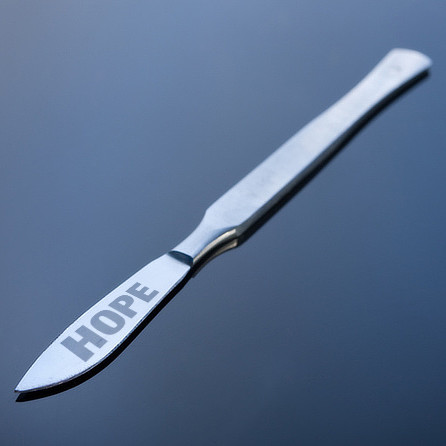Surgery for trigger points?! Cutting out the “scare” tissue

I never thought I’d write about trigger points and surgery at the same time. But here we are.
A physician reader asked for my feedback on a surgical procedure he has been offering to his patients: cutting out “trigger points,” like they are little cysts or tumours. Got a terrible, horrible, no good, very bad sore spot? Excise it!
I took my sweet time getting back to him while I worked out how to criticize this idea constructively. Snark and scorn were tempting, but I calmed down and found my politeness. He has never responded to my concerns, and so I’m going to go ahead and blog about it now — but I won’t name and shame the doctor or his clinic, because the idea is not quite as nuts as it seems at first glance. Although some of my skeptical colleagues will disagree, I think there is actually room for respectful disagreement about this.
Nevertheless, I am not exactly on Team Trigger Point Surgery. It’s not the worst idea in medicine I’ve ever heard, but it ain’t great.
Obligatory trigger point review
Trigger points are the common unexplained sore spots associated with aching and stiffness. All controversy about trigger points concerns their nature and what (if anything) we can do to treat them. No one disputes that humans do get these sore spots, and they are super annoying.
We just argue about everything thing else about them: what they are and what to do about them and how much they matter. You can read as much as you can stand about this debate on PainScience.com, but here’s an overview.
Lifelong suffering from a lot of sore spots has pried my mind open to reasonable speculation about trigger points. I consider conservative trigger point therapy to be a legitimate experimental treatment. Excision is not conservative.
Cut out the pain
I can only imagine trying to surgically excise trigger points as a last-resort option for the worst possible cases of pain, when all more cautious options have been exhausted — even the long shots.
However, as surgical procedures go, this one barely registers as “surgical.” It’s in the same league as a muscle biopsy or cutting out a cancerous mole. It’s more invasive than many injections, but arguably much less risky than some (steroids, Botox) and less silly than others (platelet-rich plasma, synovial fluid injections for knees). And it’s definitely less drastic than any true surgery (even just arthroscopy). Bear in mind that many full-blown put-you-under surgeries are routinely inflicted on chronic pain patients based on dubious assumptions about what’s wrong (like spinal fusions).
Graded on a curve, trying to snip out a painful patch of muscle is not as bonkers as it might seem at first. Unfamiliar and highly speculative, yes, but actually less worrisome than much more familiar procedures that are just as speculative and much riskier.
“Scare” tissue
The physician offering this procedure explained his reasoning: the “basic anatomic cause of trigger point is a scar or scar-like tissue formation.” If that were true, then it would indeed make sense to excise it.
But is it true? I think “scar tissue” is actually one of the weakest of all common ideas about what trigger points are and how they work — and it’s a highly problematic story to tell patients, because scar tissue is “scare tissue,” potentially a potent nocebo, a reverse placebo that makes things worse instead of better. The last thing chronic pain patients need are more reasons to worry about their tissues.
I know many chronic pain experts who will be full-blast horrified that any doctor is cutting out putative trigger points. I am not quite “horrified,” but I do think it’s a bit bizarre and a lousy choice for almost all patients.
If you like the way I write about trigger points — which is unlike anything else available on the topic — consider buying my book on the topic. It has a large free introduction.